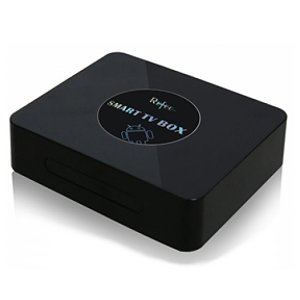XBMC
Couch potato time!
There comes a time in a man's life when he really just wants to sit on his couch between the hours of 8pm and 10.30pm. There's a correlation there to succesful procreation, and in my case at least, causation.
Kids wear you out. Long gone were the days of jumping up for every glass of water and enthousiastically pausing the movie with a thriumphant click of the mouse.
My previous media setup was centered around a windows XP media center edition pc with a trust wireless keyboard/trackball. Most of the time I'd use VLC rather than mediacenter to play movies. The pc was connected to my Onkyo TX-SR606 feeding a Sanyo PLV-Z5 projector. This worked fine until at one point it just wouldn't boot anymore.
I instead started using my Win 7 main pc, with a q6600 processor and a radeon HD4850. Not only was this overkill, but the radeon tended to get annoying when switching on the Onkyo amp. Sometimes it woud drop the sound driver, sometimes the video, and sometimes it wouldn't detect the hdmi at all. At these times I had switch off the whole chain- projector, amp, and pc- and then switch them back on again in an order that was randomly changed each time.
Not only was I wasting electricity, the pc, even in a P180 case with Noctua fans, was rather load. As a dual 90mm fan six-disk fileserver was standing in the same room, and the projector wasn't exactly quiet itself (oh for a silent, passively cooled led projector!) watching movies was really loud. The fans tended to drown out both on- and off-screen conversations.
I wanted the PCs out- preferrably in the basement in a server rack. Several requirements were attached. I needed to be able to download content. I needed to be able to watch it. I needed as little power use (and fan movement) as possible. It needed to be done cheap, using tech I had lying around. I'd like to continue using my pc. It needed to be kidsproof. And I'd prefer a remote-controlled media solution.
I was tempted to use a KVM to extend access to my main box. But that would cost a lot, limit the placement and use of the server rack, and not solve the power usage issue. I had to go do some research.
Surf's up!
Now I had been aware of XBMC for a while, as well as plex. I figured XBMC, needing only once box, would suit my needs most. I'd been looking at hardware since my SO's mini-itx went tits up. But most of the decent hardware fell into the +250 euro bracket. The exception was the apple TV, but the newest version was unhackable during the 9 months I waited for someone to do so. Eventually, ports of XBMC to android devices started to be rumored. Attention, and not just my own, focused on several devices before Pivos and XBMC devs announced they were working on an official port.
However the port would take a while to arrive and the device would not initially be sold in Europe.
The way of the chinese manufacturing world was such that, even if the Pivos box was not available in Europe, plenty of clones were. on the xbmc fora I found J1nx, a northern neighbour (that means Dutch for you non-Belgians) who had been developing linux on similar devices.
I was impressed with his confidence, and decided to follow his advice and buy the Oval Elephant TV box.

After ordering I figured out that OE was a mom and pop, or rather kids, operation that was not too far away from shutting down. But eventually, about a month and a half later, the box shipped. This was september 2012. And though initially it did work, there were many many issues with the software.
From malfunctioning ethernet, to unsupported video codecs, over a ratty remote, the box flipflopped between working fine and doing nothing. In Wife Approval Factor terms, it was a bust. I did not have the free time to fiddle with it, even if I'd been versed in fiddling with android builds- my expertise was limited to installing roms.
So I waited on the next rom, watched OE disappear, and finally installed a few roms from gBox who had a very similar product.
This improved functioning of the device somewhat, but especially larger video files still wouldn't play well. Up until January 2013, the tv box was left unused. I have to admit I was miffed, though I couldn't blame J1nx. He was hard at work releasing his own android and xbmc builds.
Meanwhile on uTorrent
I would still need a seperate box for torrenting. I started looking for ways to get this set up. Previously I'd had good results using an atom motherboard in a kludged case to run my downloads. I still had the mobo lying around, and quickly figured that Nas4Free was the linux flavor that most catered to my wishes while still being able to run on the atom motherboard.
I got a new case for the atom motherboard (having trashed it's ghetto case) and reinstalled it. I then installed Nas4free after several attempts. Basicaly disregard the explanation on their website. Burn the 'embedded' version to a cd, and then boot the cd and use it to install onto a preformatted usb stick. Ideally this is done on the mobo you want to use, but you can install on one pc and then use the stick on another.
After getting used to some idiosyncracies of setting up a linux directory for the os to use (under 'mount') I easily set up the smb and bittorrent services I wanted.
Because of the ethernet issues of the TV box, I'd set up my router's dhcp with fixed adresses- this would come in handy soon. I could now from my pc or phone control my torrents, and from any device see the smb shares. All that was required was setting up both the nas4free and the unraid fileserver in my basement.
This required drilling a hole in my (worn wooden) floor and pulling a ethernet cable across my basement, then plugging cable and servers into a bridge. I went and got a setupless bridge from a mediastore, then spent a few hours figuring out a non-crossed ethernet cable from the router needed to be in a specific port to work. Setupless indeed.
A nice surprise
J1nx had, from the beginning, been singing the praise of linux instead of android as an XBMC platform. If you don't know how android works, it's basically a Java 'virtual machine' running on a more basic linux OS. Apps are executed by this virtual machine, 'Dalvik'. I'm fuzzy on the details, but according to J1nx XBMC running directly on linux would gain a speed boost at the least.
So I was very pleased come March 2013 to Find not an android, but a linux build for my TV box!
Installation was a cinch- just download the .zip on an SD card and use the reset button to boot into the android Recovery menu. From there 'instal update' and just browse to the sd card.
After I found I had a much improved experience. Enough to show of to my SO, even.
And, after a 2nd update, even good enough to send my main pc to the guest room. The OE box is now our main media box, offering movies and youtube playback.
There are still some issues, some of which are likely hardware related. But despite some teething problems the workflow is fine and allows me hat I was looking for, a (nearly) fan-free, couch-based media experience.
Onwards
At the moment the XBMC experience is working fine. I can't use the android remote control app which would be neat, and it's a bit annoying waiting for my unraid disks to spin up, but apart from that I'm happy and not eager to update the setup. I'll likely update to new linux releases hoping to get some stability, though.
I'll do a more thorough writeup/mini manual on the XBMC use later on, too.
